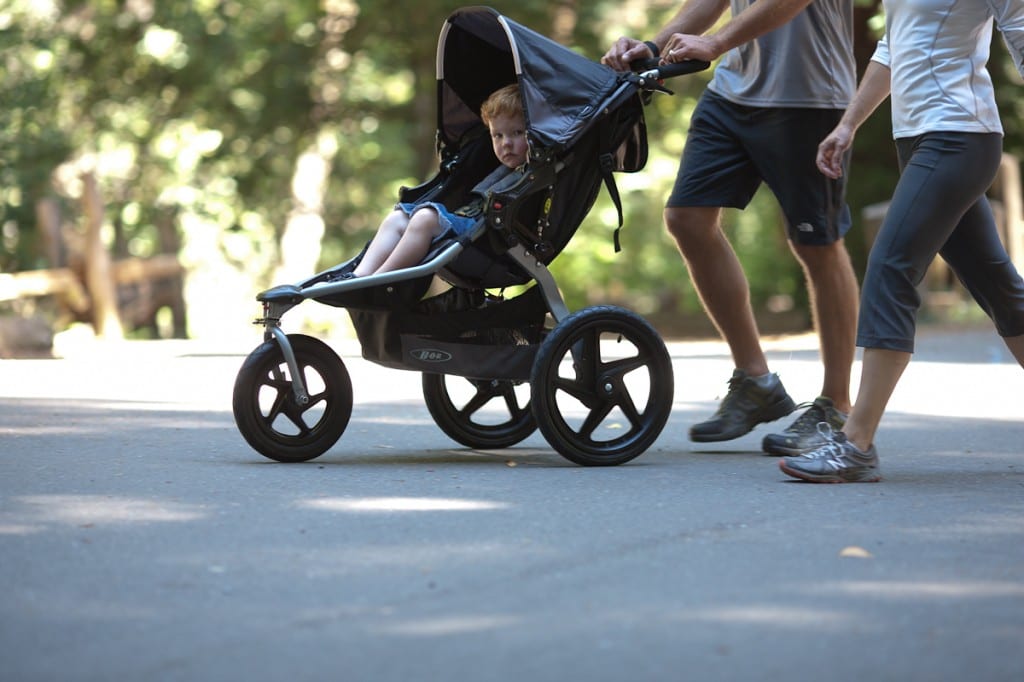Designed to meet every need and price point – and available in every shape, size and color – today’s strollers are as much fashion accessory as utilitarian device. Manufacturers range from trusted industry giants to entrants from abroad and, increasingly, a number of up-and-coming brands that have injected a fresh take on stroller design. A little confused with all these options? Not sure where to dive in? Here’s a quick guide to help you choose a stroller (or strollers!) that’s right for you.
When deciding on a stroller, your child’s comfort is no doubt important. After all, if he or she doesn’t want to ride in the stroller, you’re going to find yourself pushing jackets and bags around town while your child runs wild. However, don’t forget to consider your own comfort as well. Find one that is the right height, so that you’re not stooped over or reaching too high. Grip the handles to find ones that give you a secure hold while being oriented in a way that feels natural.
Consider whether you’ll need to fold and stow your stroller often. If you’re just using it around the neighborhood and can leave it in your garage, ease of folding may not be an issue. On the other hand, if you’re storing the stroller in your car trunk or a small entryway, a compact fold is a must. Weight should also be a factor should you need to lift the stroller regularly – including lifting it into and out of your car.
The next thing to consider is where you will be using your stroller. Are you planning to stroll the open streets or navigate narrow store aisles? Going for long walks or short trips? Smaller strollers will get you through tight spots and will be easier to maneuver. On the flip side, bigger strollers with larger wheels lend more stability and provide a smoother ride. Planning to go off-road? Air-filled tires on a three-wheel base are your best bet.
Your child’s age and the number of years you hope to get out of your stroller should also factor into stroller choice. A child under six months requires a greater recline position until he can sit upright and hold his head up. Alternatively, many strollers now come with a bassinet option or have attachments that accommodate an infant car seat.
Safety-wise, you can check that strollers are certified by the Juvenile Products Manufacturers Association (JPMA) and meet ASTM International requirements. Most major brands have gone through certification, which includes inspecting everything from restraint systems to brakes, but note that these programs are voluntary. So, just because a stroller doesn’t boast these certifications doesn’t mean you should worry. Just to be in the market, strollers need to pass strict safety tests.
Now that you have the basics down, what type of stroller is right for you? And do you need more than one? Here are five of the most popular stroller categories and our favorite models under each.
Standard strollers are great for everyday use and, as the name implies, perfect for “standard” conditions like city pavement. If you only want one stroller, you’ll likely want one of these. It’s sturdier and takes rough terrain better than an umbrella stroller, but the tradeoff is a heavier, less compact frame.
Umbrella strollers are known for being exceptionally lightweight, compact and foldable, features that make them especially popular with grandparents and patrons of public transportation. Given their minimal design, they are typically the most affordable stroller.
Jogging strollers are ideal for active parents who need a stroller that can keep up with a quick pace. While originally designed for jogging, this stroller is now the choice of a wider range of parents, who turn to this stroller for greater stability (three-wheel base) and smooth travel over rough terrain (large air-filled tires, lockable front swivel wheels and quality suspension systems) – even if that rough terrain is just uneven pavement! These strollers are best for the outdoors, as their size makes it difficult to navigate narrow aisles and doorways, as well as fit into small car trunks. In addition, given their heft and inability to stand upright due to their large wheels, they tend to be awkward in their collapsed state. Note that jogging or going off-road is not recommended with children under 8 months.
Double strollers provide comfortable travel for two children at a time and come in standard, umbrella and jogging styles. They vary in how they accommodate two children, with some positioning them one in front of the other and others seating children side by side. Depending on configuration, some require one child to be old enough to stand or sit upright on her own. Because these are bigger strollers, they tend to be heavier and harder to steer. They are still much easier than trying to negotiate multiple strollers. Note that if you have even more children, there are now triple and quadruple stroller options as well.
Luxury strollers take strollers to a completely new level with innovative design and engineering that rethinks every aspect. With a higher price point, these models impress with carefully thought-through features that revolutionize a product that’s been around since the 18th century.
